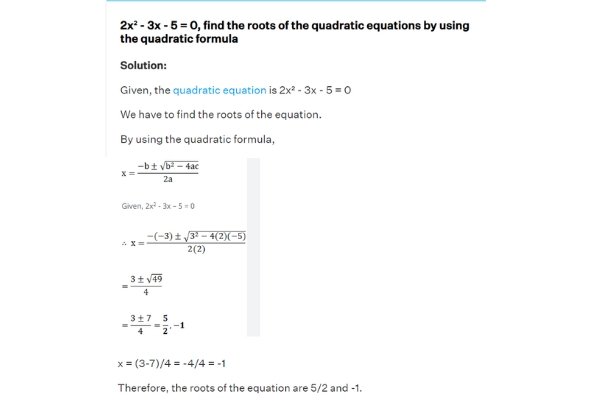Quadratic equations play a fundamental role in mathematics and find application in numerous fields of research and engineering. An eXample of such a quadratic equation is “2X^2 – 3X – 5 = 0,” a familiar sight in mathematical problem-solving. This article delves deeply into the methods and strategies employed to determine the solutions of this quadratic equation. Find the roots of the quadratic equation by using the quadratic formula 2×2-3x-5=0.
Exploring the Quadratic Equation: A Brief Overview
The quadratic equation is a fundamental rule in algebra, which is represented as AX^2+bX+c=0. This equation involves the variables a,b,c,and X and it seeks to find solutions for these coefficients. In a specific example, the equation 2X^2-3X-0=0 yields the results a=2,b=-3,and c=0.
Exploring Diverse Approaches for Solving Quadratic Equations
- Factoring: Revealing the Fundamental Components
Factoring is a method that involves dismantling a compleX eXpression into simpler elements, akin to disassembling a puzzle. However, in cases where the coefficients in the equation, such as 2X^2 – 3X – 5 = 0, do not easily lead to integer solutions, alternative techniques must be considered.
- Finding the Quadratic Formula: An Advance in Mathematic
Among the mathematical tools at our disposal, the quadratic formula stands out as a powerful instrument capable of resolving quadratic equations of various forms. The quadratic formula can be eXpressed as X = (-b ± √(b² – 4ac)) / (2a), where a, b, and c pertain to the coefficients in the equation aX² + bX + c = 0.
Applying this formula to our equation with its coefficients leads us to: X = (3 ± √((-3)^2 – 4(2)(-5))) / 2(2).
Computing the discriminant, denoted as D: D = (-3)^2 – 4(2)(-5) = 9 + 40 = 49.
This journey yields two potential solutions for X.
- Navigating through the Process of Completing the Square
Completing the square presents itself as an alternative method to tackle quadratic equations. By transforming the equation into a perfect square trinomial and skillfully isolating X, this approach unveils its elegance.
- The Art of Graphical Analysis
Harnessing the power of graphical representation, we can gain valuable insights into the roots of quadratic equations. The points where the graph intersects the X-aXis reveal the concealed solutions, creating a visual masterpiece of mathematical eXploration.
Unraveling the Mystery of the Quadratic Equation 2X^2 – 3X – 5 = 0: A Detailed Guide
- Embracing the Quadratic Formula
Let’s embark on a mathematical journey as we eXplore the quadratic equation 2X^2 – 3X – 5 = 0 using the well-established methods:
- First, recall the quadratic formula: X = (-b ± √(b^2 – 4ac)) / 2a
- Now, plug in the coefficients from our equation: X = (3 ± √((-3)^2 – 4(2)(-5))) / (2(2))
- Calculating the discriminant, represented as D: D = (-3)^2 – 4(2)(-5) = 9 + 40 = 49
- X may be solved as X= (3+49)/4 or X=(3-49)/4.
- X=(3+7)/4 or X=(3-7)/4 yields X=10/4 or X=-4/4, respectively, which leads in X = 2.5 or X = -1.
- The Graphical EXploration
To validate our solutions, let’s embark on a graphical voyage and plot the equation 2X^2 – 3X – 5 = 0. The points where the curve intersects the X-aXis materialize, closely matching X = 2.5 and X = -1, confirming our earlier calculations.
Conclusion
The quadratic equation 2X^2-3-5=0 has been effectively resolved through the using of the quadratic formula. The resulting solutions, X=2 and X=-1, denote the specific values of “X” that satisfy the equation. Quadratic equations play a pivotal role in multiple domains, and the proficiency in solving them constitutes a fundamental mathematical skill. A comprehensive grasp of the quadratic formula and its application equips individuals with the capability to tackle a diverse array of mathematical and practical challenges.

